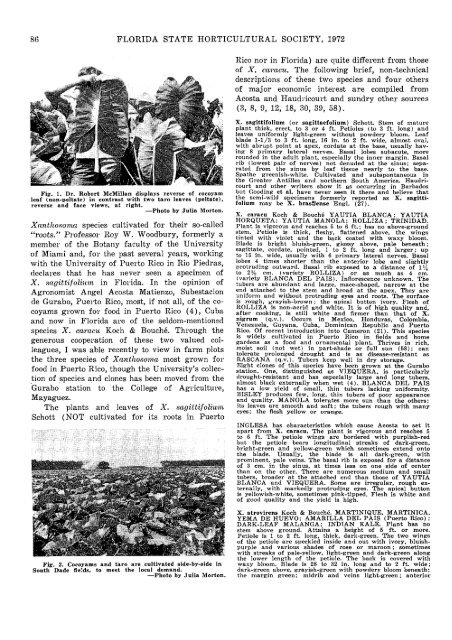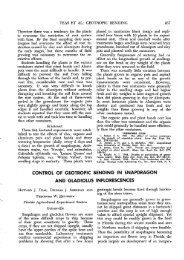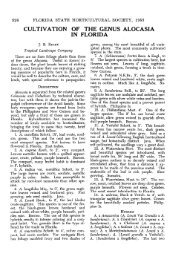(xanthosoma caracu, x. atrovirens and x. nigrum), ancient root
(xanthosoma caracu, x. atrovirens and x. nigrum), ancient root
(xanthosoma caracu, x. atrovirens and x. nigrum), ancient root
You also want an ePaper? Increase the reach of your titles
YUMPU automatically turns print PDFs into web optimized ePapers that Google loves.
86 FLORIDA STATE HORTICULTURAL SOCIETY, 1972<br />
Fig. 1. Dr. Robert McMillan displays reverse of cocoyam<br />
leaf (non-peltate) in contrast with two taro leaves (peltate),<br />
reverse <strong>and</strong> face views, at right.<br />
—Photo by Julia Morton.<br />
Xanthosoma species cultivated for their so-called<br />
"<strong>root</strong>s." Professor Roy W. Woodbury, formerly a<br />
member of the Botany faculty of the University<br />
of Miami <strong>and</strong>, for the past several years, working<br />
with the University of Puerto Rico in Rio Piedras,<br />
declares that he has never seen a specimen of<br />
X. sagittifolium in Florida. In the opinion of<br />
Agronomist Angel Acosta Matienzo, Subestacion<br />
de Gurabo, Puerto Rico, most, if not all, of the co-<br />
coyams grown for food in Puerto Rico (4), Cuba<br />
<strong>and</strong> now in Florida are of the seldom-mentioned<br />
species X. <strong>caracu</strong> Koch & Bouche. Through the<br />
generous cooperation of these two valued col<br />
leagues, I was able recently to view in farm plots<br />
the three species of Xanthosoma most grown for<br />
food in Puerto Rico, though the University's collec<br />
tion of species <strong>and</strong> clones has been moved from the<br />
Gurabo station to the College of Agriculture,<br />
Mayaguez.<br />
The plants <strong>and</strong> leaves of X. sagittifolium<br />
Schott (NOT cultivated for its <strong>root</strong>s in Puerto<br />
Fig. 2. Cocoyams <strong>and</strong> taro are cultivated side-by-side in<br />
South Dade fields, to meet the local dem<strong>and</strong>.<br />
—Photo by Julia Morton.<br />
Rico nor in Florida) are quite different from those<br />
of X. <strong>caracu</strong>. The following brief, non-technical<br />
descriptions of these two species <strong>and</strong> four others<br />
of major economic interest are compiled from<br />
Acosta <strong>and</strong> Haudricourt <strong>and</strong> sundry other sources<br />
(3, 8, 9, 12, 18, 30, 39, 58).<br />
X. sagittifolium (or sagittaefolium) Schott. Stem of mature<br />
plant thick, erect, to 3 or 4 ft. Petioles (to 3 ft. long) <strong>and</strong><br />
leaves uniformly light-green without powdery bloom. Leaf<br />
blade 1-1/3 to 3 ft. long, 16 in. to 2 ft. wide, almost oval,<br />
with abrupt point at apex, cordate at the base, usually hav<br />
ing 8 primary lateral nerves. Basal lobes subacute, more<br />
rounded in the adult plant, especially the inner margin. Basal<br />
rib (lowest pair of nerves) not denuded at the sinus; sepa<br />
rated from the sinus by leaf tissue nearly to the base.<br />
Spathe greenish-white. Cultivated <strong>and</strong> subspontaneous in<br />
the Greater Antilles <strong>and</strong> northern South America. Haudri<br />
court <strong>and</strong> other writers show it as occurring in Barbados<br />
but Gooding et al. have never seen it there <strong>and</strong> believe that<br />
the semi-wild specimens formerly reported as X. sagitti<br />
folium may be X. brasilense Engl. (27).<br />
X. <strong>caracu</strong> Koch & Bouche YAUTIA BLANCA; YAUTIA<br />
HORQUETA; YAUTIA MANOLA; ROLLIZA; TRINIDAD.<br />
Plant is vigorous <strong>and</strong> reaches 5 to 6 ft.; has no above-ground<br />
stem. Petiole is thick, fleshy, flattened above, the wings<br />
tinted with violet <strong>and</strong> the back coated with waxy bloom.<br />
Blade is bright bluish-green, glossy above, pale beneath;<br />
sagittate, cordate, pointed, 1 to 2 ft. long <strong>and</strong> larger; up<br />
to 15 in. wide, usually with 6 primary lateral nerves. Basal<br />
lobes 4 times shorter than the anterior lobe <strong>and</strong> slightly<br />
protruding outward. Basal rib exposed to a distance of 1*4<br />
to 2M> cm. (variety ROLLIZA) or as much as 4 cm.<br />
(variety BLANCA DEL PAIS). Inflorescence unknown. The<br />
tubers are abundant <strong>and</strong> large, mace-shaped, narrow at the<br />
end attached to the stem <strong>and</strong> broad at the apex. They are<br />
uniform <strong>and</strong> without protruding eyes <strong>and</strong> <strong>root</strong>s. The surface<br />
is rough, grayish-brown ; the apical button ivory. Flesh of<br />
ROLLIZA is non-acrid <strong>and</strong> white. It is of high quality <strong>and</strong>,<br />
after cooking, is still white <strong>and</strong> firmer than that of X.<br />
<strong>nigrum</strong> (q.v.). Occurs in Mexico, Honduras, Colombia,<br />
Venezuela, Guyana, Cuba, Dominican Republic <strong>and</strong> Puerto<br />
Rico. Of recent introduction into Cameron (21). This species<br />
is widely cultivated in Puerto Rico in fields <strong>and</strong> home<br />
gardens as a food <strong>and</strong> ornamental plant. Thrives in rich,<br />
moist soil (not wet) in part-shade or full sun (58); can<br />
tolerate prolonged drought <strong>and</strong> is as disease-resistant as<br />
RASCANA (q.v.). Tubers keep well in dry storage.<br />
Eight clones of this species have been grown at the Gurabo<br />
station. One, distinguished as VIEQUERA, is particularly<br />
drought-resistant <strong>and</strong> has especially large <strong>and</strong> long tubers,<br />
almost black externally when wet (4). BLANCA DEL PAIS<br />
has a low yield of small, thin tubers lacking uniformity.<br />
BISLEY produces few, long, thin tubers of poor appearance<br />
<strong>and</strong> quality. MANOLA tolerates more sun than the others;<br />
its leaves are smooth <strong>and</strong> soft; the tubers rough with many<br />
eyes; the flesh yellow or orange.<br />
INGLESA has characteristics which cause Acosta to set it<br />
apart from X. <strong>caracu</strong>. The plant is vigorous <strong>and</strong> reaches 5<br />
to 6 ft. The petiole wings are bordered with purplish-red<br />
but the petiole bears longitudinal streaks of dark-green,<br />
bright-green <strong>and</strong> yellow-green which sometimes extend onto<br />
the blade. Usually, the blade is all dark-green, with<br />
prominent, pale veins. The basal rib is exposed for a distance<br />
of 3 cm. in the sinus, at times less on one side of center<br />
than on the other. There are numerous medium <strong>and</strong> small<br />
tubers, broader at the attached end than those of YAUTIA<br />
BLANCA <strong>and</strong> VIEQUERA. Some are irregular, rough ex<br />
ternally, with markedly protruding eyes. The apical button<br />
is yellowish-white, sometimes pink-tipped. Flesh is white <strong>and</strong><br />
of good quality <strong>and</strong> the yield is high.<br />
X. <strong>atrovirens</strong> Koch & Bouche. MARTINIQUE, MARTINICA,<br />
YEMA DE HUEVO; AMARILLA DEL PAIS (Puerto Rico) ;<br />
DARK-LEAF MALANGA; INDIAN KALE. Plant has no<br />
stem above ground. Attains a height of 5 ft. or more.<br />
Petiole is 1 to 2 ft. long, thick, dark-green. The two wings<br />
of the petiole are speckled inside <strong>and</strong> out with ivory, bluishpurple<br />
<strong>and</strong> various shades of rose or maroon; sometimes<br />
with streaks of pale-yellow, light-green <strong>and</strong> dark-green along<br />
the lower length of the petiole. The back is covered with<br />
waxy bloom. Blade is 28 to 32 in. long <strong>and</strong> to 2 ft. wide;<br />
dark-green above, grayish-green with powdery bloom beneath;<br />
the margin green; midrib <strong>and</strong> veins light-green; anterior





